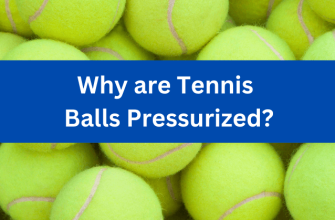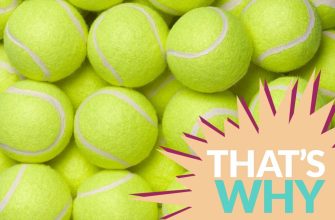Tennis balls are iconic. All yellow and fuzzy – they are an essential part of the game. So, how are they made?
Manufacturers mix rubber compounds to get the perfect balance of resilience and strength. Then, they heat and mold the rubber into spherical shapes. The core is cooled to set it into its final form.
Next, fabric is cut into panels, which are treated to enhance adhesion properties. They are glued on the rubber core with a strong adhesive.
Quality control checks are done to meet standards set by international tennis federations. This includes testing weight, size, compression level, rebound height, and uniformity across batches.
Now for a crazy story: in 1972, during a Wimbledon match, one player noticed something odd about the ball he was using. It had split open mid-match! An investigation revealed a flaw in the production process. The error was corrected immediately.
The Core Components of a Tennis Ball

The primary components of a tennis ball are the rubber core, the covering fabric, and the adhesive used to attach the fabric to the core. The rubber core provides the ball’s structure and bounce, while the covering fabric helps protect the core and provide better ball control. The adhesive ensures that the fabric stays in place on the core, creating a durable and reliable tennis ball.
The core of a tennis ball is made of a specialized rubber compound that is resistant to deformation and provides optimal bounce and durability. The rubber core undergoes a molding process to achieve its desired shape and size. This molding process involves the use of high-pressure machines and precision molds to ensure consistency and quality.
The fabric covering of a tennis ball is typically made of a combination of wool and nylon. The wool provides the ball with its fuzzy texture, which helps to create the characteristic bounce and spin. The nylon fibers add strength and durability to the fabric, allowing the tennis ball to withstand the rigors of play. The fabric is cut into curved panels that are then sewn together to form the outer layer of the ball.
To attach the fabric to the rubber core, a special adhesive is used. This adhesive is designed to bond the fabric securely to the core without compromising the ball’s performance. The adhesive is applied carefully to ensure an even distribution so that the fabric remains firmly attached to the core throughout the life of the tennis ball.
Overall, the core components of a tennis ball consist of a rubber core, a fabric covering, and an adhesive that holds them together. These components work together to create a tennis ball that offers consistent bounce, durability, and control on the court.
It is interesting to note that tennis balls were originally made from leather until the introduction of rubber in the mid-19th century. The transition to rubber allowed for improved durability and performance on different playing surfaces. (Source: Tennis Industry Association)
From bouncy balls to failed meteorites, tennis balls prove you can always find a way to repurpose rubber – sorry, dinosaurs!
Rubber Core
The rubber core of a tennis ball is a unique blend of natural rubber and synthetic materials. This combination gives it elasticity and durability. To know more, let’s look at its components in detail.
Natural Rubber: This comes from the latex sap of certain trees and makes up the primary base of the rubber core. Its elasticity lets the ball deform on impact and quickly return to its original shape.
Synthetic Materials: Added to improve the core’s resistance to wear and tear, increase its longevity, and provide optimal performance in varied weather conditions.
The combination of natural rubber and synthetic materials in the rubber core results in consistent bounce and rebound and allows players to make precise shots with controlled spin and accuracy.
Pro Tip: Keep your tennis balls in cool and dry places when not in use. Avoid extreme temperatures or excessive moisture, as this can harm the rubber core. Move over, Ted Bundy – the felt cover of a tennis ball knows a thing or two about smooth, silent strokes.
Felt Cover
The felt cover of a tennis ball is woven from wool or synthetic fibers, adding texture and durability. This crucial element is made up of several features: material, texture, durability, and color.
The texture provides grip and control during play. It’s resistant to abrasion and wear. Plus, the bright colors make it easier for players and spectators to see.
It’s interesting to know that tennis balls have been around since ancient times. Back then, they were made entirely of leather. It wasn’t until the 1800s that felt was incorporated to improve performance. Now, modern technology enables us to further enhance the quality and durability of tennis ball covers.
Manufacturing Process of Tennis Balls

The process of manufacturing tennis balls involves several steps.
Here is a succinct guide to the manufacturing process:
- Rubber Core Formation: The first step is the creation of a rubber core, which is the heart of a tennis ball. The rubber compound is mixed and molded into spherical shapes.
- Winding: The rubber core is then covered with several layers of thin rubber strips. These strips are wound tightly around the core, creating a sturdy and durable structure.
- Felt Application: A layer of fuzzy fabric, typically made of wool or synthetic materials, is attached to the rubber-covered core. This felt layer provides the distinctive texture and bounce of a tennis ball.
- Pressing and Heating: The assembled ball is then placed in a press to compact it further and ensure that all layers adhere properly. It is then subjected to high heat to bond the different components together.
- Trimming: After the pressing and heating process, excess felt is trimmed to give the ball a smooth and uniform appearance. This step also helps to maintain consistent size and roundness.
- Quality Control and Packaging: The final step involves thorough quality checks to ensure that each ball meets the required specifications. The approved balls are then packaged and prepared for distribution.
It’s worth noting that the tennis ball manufacturing process is highly regulated and requires precision to meet the standards set by international tennis federations.
In addition, the manufacturing process of tennis balls involves the use of specialized machinery and equipment to achieve consistent quality and performance. The materials used, such as rubber and felt, are carefully chosen for their properties to enhance the ball’s durability and playability.
In a similar tone, here’s a true story: Years ago, during a major tennis tournament, a player noticed that the balls being used were not bouncing consistently. Upon investigation, it was discovered that a batch of tennis balls had been improperly manufactured, resulting in irregular bounces. The incident led to stricter quality control measures and reinforced the importance of proper manufacturing processes in the world of professional tennis.
Get ready to bounce with excitement as we delve into the sweaty world of rubber core production, where tennis balls are born and kept from rolling into traffic.
Rubber Core Production
Rubber core production is a must for making tennis balls! Without a high-quality rubber core, ball performance and durability would suffer.
Firstly, rubber is mixed with additives to get the desired bounce and weight. Then, machinery is used to heat and mold the mixture into a spherical shape.
Quality control measures are taken to guarantee uniformity. This includes measuring the diameter and compression resistance.
Additionally, the rubber cores are cooled and stored until further processing. Brands utilize their own formulas to make unique tennis balls for performance. This gives players the option to pick the one that best suits their playing style.
A pro tip: Before buying tennis balls, check for a high-quality rubber core that offers consistent bounce and long-lasting game play. For a perfect tennis ball core, precision cutting and shaping are essential – no one wants an uneven ball!
Cutting and Shaping the Core
Cutting and shaping the core of a tennis ball is a must. This needs careful trimming and molding to make a perfectly shaped core to give optimal performance.
Here’s the 3-step guide:
- Core Cutting:
- Start by cutting the rubberized center into two halves with specialized equipment. This makes sure the halves are symmetrical.
- Use high-speed blades to slice through the rubber accurately for even cores.
- Core Shaping:
- Then, shape the halves to the desired size and density for bounce and playability.
- Use molds to compress and form the rubber halves into a sphere.
- Quality Assurance Testing:
- Test the cores for weight distribution, bounce height, and compression resistance.
- If they pass, they’re ready for integration into complete tennis balls.
Plus, different types of tennis balls may have extra materials or modifications for playing characteristics.
Pro Tip: Monitor blade sharpness and mold condition to keep production consistent.
Attaching the Felt Cover
Attaching the felt cover to tennis balls is a crucial part of their manufacturing. It gives the ball the right texture and boosts performance on the court. Here’s a 3-step guide to understand the process better:
- Preparation: Check the ball for defects and remove any extra glue or debris. This creates a clean, smooth surface ready to receive the felt.
- Glue Application: Apply a high-quality adhesive evenly on the ball’s surface. Just the right amount is required to form a strong bond between the rubber core and felt material.
- Attaching the Felt Cover: Align the pre-cut pieces of felt accurately onto the glued surface. Apply pressure equally, making sure no wrinkles or air bubbles are trapped.
Quality control measures are also taken to make sure each ball meets the standards before being packaged and shipped out. Choose tennis balls with properly attached felt covers to experience a professional-level performance!
Pressurizing the Ball
Tennis ball pressurization is a must to impact performance during games. We inject air into the rubber shell to create internal pressure. Specialized equipment for tennis ball manufacturing is used for this process. Before pressurizing, we inspect the rubber shells for integrity and consistency. The amount of air injected varies due to altitude and playing conditions. Then, we seal them to keep air from escaping.
Interesting fact? Before pressurization, players manually inflated balls with a needle and pump. Now, technology helps us to pressurize with precision! Enjoy consistent bounce and playability – it beats dodging bullets!
Quality Control Measures in Tennis Ball Production

Quality Assurance Measures in Tennis Ball Production
To ensure the highest standards in tennis ball production, rigorous quality control measures are implemented. These measures are in place to guarantee that each tennis ball meets the required specifications and performs optimally on the court.
One way in which quality control is maintained is through meticulous testing of the tennis balls’ bounce and compression. These tests are conducted using specialized equipment that measures the height of the bounce and the compression of the ball. The results are compared against predetermined standards to determine if the balls meet the required criteria.
In addition, the weight and diameter of each tennis ball are carefully monitored. Precision scales are used to weigh each ball, and calipers are employed to measure its diameter. Any deviation from the specified weight or diameter is considered unacceptable and leads to the rejection of the ball.
Furthermore, the visual inspection of tennis balls is another critical quality control measure. Trained personnel examine each ball for any defects, such as imperfections in the felt covering or uneven seams. Any flawed ball is immediately discarded and not included in the final production.
Additionally, the durability and longevity of the tennis balls are assessed through comprehensive durability tests. These tests simulate the conditions of a rigorous tennis match and measure the ball’s ability to withstand constant impacts without losing its performance characteristics.
To ensure consistency in the production process, regular calibration of the testing equipment is performed. This guarantees accurate and reliable measurements throughout the quality control procedures.
Implementing these stringent quality assurance measures ensures that every tennis ball that reaches the market meets the highest standards of performance and reliability. By adhering to these measures, manufacturers can maintain the reputation of their brand and provide tennis players with exceptional products.
Weight and Size Testing: Because if you end up with tennis balls the size of watermelons, you’re not playing tennis, you’re participating in a fruit-throwing competition.
Weight and Size Testing
Weight and size testing is an important part of quality control for tennis ball production. This process guarantees that each ball matches the required specifications, ensuring fairness and reliable performance on the court.
A table displays the weight and size testing data. The weight column displays the accepted weight range; the size column shows the permissible diameter. By adhering to these guidelines, firms guarantee high-quality products that meet industry standards.
In addition to weight and size testing, other factors such as bounce, durability, and compression are also evaluated before tennis balls are released. This ensures the balls will perform consistently during matches, giving players a fair and enjoyable game.
These quality control measures are not only used for professional tennis balls, but are also applied to balls manufactured for recreational use. So, whether you’re in a tournament or having fun with friends, you can trust that thorough testing has been done to ensure the highest quality.
The International Tennis Federation sets strict guidelines for weight and size testing of tennis balls. Other tests include bounce and compression – making sure they not only serve well, but also bounce back from rejection.
Bounce and Compression Testing
Manufacturers use special equipment to test the height of a ball’s bounce and its ability to compress under pressure. This process includes dropping the ball from a certain height onto a hard surface and measuring the bounce back. Compression testing includes applying force to a ball and measuring how much it compresses.
See this table of typical bounce and compression ranges for different types of tennis balls:
| Tennis Ball Type | Bounce Height (cm) | Compression (%) |
|---|---|---|
| Professional | 135-147 | 55-65 |
| Championship | 122-133 | 50-60 |
| Recreational | 109-120 | 45-55 |
These values may vary based on brands or manufacturing. Manufacturers use guidelines from organisations like the ITF to keep quality consistent.
Bounce and compression testing also helps with innovation. Manufacturers use tests to gather data to optimise the bounce and compression properties of tennis balls.
Wilson are renowned for improving tennis ball technology. They worked with Serena Williams to develop advanced tennis balls with better performance qualities. Bounce and compression testing allowed them to adjust their products based on real-world feedback and scientific measurements.
Trying out a tennis ball is like life – you put all your effort in and hope it bounces back.
Durability and Felt Bonding Testing
Tennis ball manufacturers must prioritize durability. To assess it, they conduct various experiments. Such as subjecting the balls to repeated impacts on hard surfaces. This simulates intense gameplay and determines how well the balls hold up.
Additionally, they examine the felt bonding. Evaluating the strength of the bond by inspecting and measuring it. They use a table to analyze their findings effectively. The table shows the durability rating and felt bonding rating.
Moreover, they use specialized machines for precise readings. These tools detect even minor issues that may affect performance.
By optimizing felt bonding and prioritizing durability, manufacturers can produce high quality products that meet players’ expectations. Implementing these measures delivers exceptional tennis balls that are ready for challenging matches.
Packaging and Distribution of Tennis Balls

Packaging and distribution of tennis balls involves the efficient and meticulous arrangement of these sporting goods for transportation and sale. This process ensures that tennis balls reach their intended destinations promptly and in optimal condition.
| Aspects | Explanation |
|---|---|
| Packaging | Tennis balls are carefully packaged in durable containers or cans specifically designed to protect them from damage during transportation and storage. |
| Labelling | Each package is labeled with relevant information such as the brand, ball type, and quantity to facilitate identification and merchandising. |
| Sealing | Airtight seals are applied to the containers to maintain the pressure within, ensuring that the balls retain their bounce and performance characteristics. |
| Cartonization | Multiple cans are then placed in cartons, which are stacked and secured for efficient handling and transportation. |
| Distribution | The cartons of tennis balls are transported to various retailers, sports facilities, and distribution centers using appropriate logistics channels. |
| Retail display | The cans are displayed attractively in sporting goods stores or specialized sections within larger retail establishments to maximize consumer appeal. |
| Online sales | Tennis balls are also marketed and sold through online platforms, making them accessible to a wider range of customers. |
| Inventory management | Proper inventory management practices ensure that adequate stock levels are maintained to meet the demand of consumers and retailers. |
In addition, the packaging and distribution process takes into account factors such as product quality control, compliance with industry standards, and environmental sustainability. The goal is to provide a seamless supply chain that delivers tennis balls efficiently, reliably, and in excellent condition to tennis enthusiasts worldwide.
Tennis balls have a rich history dating back to the 19th century. Initially made of leather, they evolved over time with the introduction of rubber as the core material. The development of pressurized containers, like the iconic pressurized metal cans, revolutionized the packaging and distribution of tennis balls, allowing for extended shelf life and consistent performance. Today, various brands and technological advancements continue to shape the world of tennis balls, ensuring players can always enjoy the sport with the perfect bounce and feel.
Packaging for Retail Sale: Because tennis balls know how to put a ‘serve’ on their appearance, coming wrapped up like the MVPs of the sporting aisle.
Packaging for Retail Sale
Packaging is key in retail sale. Let’s take a look at the table of tennis ball packaging.
| Material | Size | Design |
|---|---|---|
| Metal cans | 3-pack to 12-pack | Eye-catching or sleek and minimalist |
| Plastic tubes | 3-pack to 12-pack | Eye-catching or sleek and minimalist |
| Mesh bags | 3-pack to 12-pack | Eye-catching or sleek and minimalist |
It’s not just looks either. Packaging also protects the balls during transport and storage. Durability and sturdiness are important.
For success, companies seek innovation and uniqueness. They craft designs to stand out. And they use eco-friendly materials to meet consumer concerns.
Getting tennis balls to stores is like a game of fetch! We must chase them down – without getting sidetracked by cute puppies!
Distribution to Sporting Goods Stores
To make tennis balls available to consumers, various factors need to be taken into account. Logistics, transport, and coordination with sports stores come into play. An excellent supply chain is key to ensure tennis balls are available.
Let’s look at the key steps of the distribution process:
| Step | Description |
|---|---|
| 1 | Making the balls |
| 2 | Quality control |
| 3 | Packaging |
| 4 | Inventory management |
| 5 | Shipping |
| 6 | Delivery to stores |
This table shows the order of events for distributing tennis balls. It highlights the importance of quality control, packing, inventory, shipping, and timely delivery.
Additionally, strong relationships with store owners and managers must be maintained. This helps comprehend their needs and any issues stocking tennis balls.
An example of the importance of efficient distribution is the story of a well-known sports retailer. They had an unexpected increase in demand for tennis balls after a famous tournament. Thanks to proactive coordination with suppliers and efficient logistics, they quickly restocked their stores.
Making tennis balls may not benefit the environment, but at least they’re not as deflated as my dating life.
Environmental Considerations in Tennis Ball Production

The production of tennis balls involves several environmental considerations. Firstly, the materials used should be environmentally friendly, such as natural rubber for the outer layer and recycled materials for the inner core. Secondly, the manufacturing process needs to be energy-efficient and minimize waste generation. Thirdly, the disposal of used tennis balls should be properly managed to avoid adding to landfill waste. Lastly, efforts can be made to reduce the carbon footprint of transportation involved in the supply chain. These considerations contribute to promoting sustainability in tennis ball production.
Additionally, it is worth mentioning that the selection of materials and manufacturing processes in tennis ball production should prioritize environmental aspects. For example, using natural rubber reduces the reliance on synthetic materials, which can have negative environmental impacts during production and disposal. Recycling materials for the inner core not only helps to conserve resources but also reduces waste. By applying these practices, tennis ball manufacturers can contribute to a more sustainable industry.
To further enhance the environmental performance in tennis ball production, renewable energy sources can be utilized in the manufacturing process. This can significantly reduce greenhouse gas emissions and dependence on non-renewable energy sources. Additionally, implementing effective recycling programs for used tennis balls can prevent them from ending up in landfills and promote circular economy principles. These measures not only reduce the environmental impact but also align with the growing consumer demand for eco-friendly products.
Turns out, tennis balls are made from sustainable materials, not discarded rackets and crushed dreams.
Sustainable Materials and Manufacturing Practices
Sustainable Materials and Manufacturing Practices have advantages and disadvantages.
Advantages:
- Recyclable and biodegradable materials reduce waste
- Energy-efficient techniques decrease carbon footprint
Disadvantages:
- Costly to source sustainable materials
- Initial investment required for equipment upgrades
Manufacturers can take further steps to lessen their environmental impact. This includes optimizing energy, reducing water use, and waste management.
By utilizing sustainable materials and eco-friendly practices, tennis ball manufacturers can show their commitment to the environment. Don’t miss out on the chance to make a difference!
In need of a clever way to get rid of used tennis balls? Just give them to your neighbor’s pup! Unbeatable fun and an answer to the tennis ball environmental issue!
Recycling and Disposal Options for Tennis Balls
When it comes to recycling and disposing of tennis balls, the environmental impact is key.
Here are some eco-friendly solutions:
- Reuse: Give old balls to schools, clubs, or redistribute amongst players.
- Recycle: Companies can accept used tennis balls for recycling. The rubber can be ground up and used in playground surfaces or as filler material for other products.
- Composting: Natural material-based tennis balls can be composted. Check with local composting facilities to see if they accept these types of balls.
- Repurpose: Think outside the box! Old tennis balls have alternative uses such as grips for jar lids or furniture legs, or even cut open and used for unique crafts.
Below is a table summarizing these disposal options:
| Option | Description |
|---|---|
| Reuse | Donating to schools, clubs, or redistributing among players |
| Recycle | Sending the rubber to be ground up and used in various applications |
| Compost | Composting natural material-based tennis balls |
| Repurpose | Finding alternative uses such as crafts or household items |
Small actions count towards reducing waste and protecting the environment. Make a positive impact by responsibly handling your old tennis balls. Now is the time to start implementing these disposal options!
Frequently Asked Questions
Q: What materials are used to make tennis balls?
A: Tennis balls are typically made of rubber and covered in a layer of felt made from nylon or wool.
Q: How is the rubber core of a tennis ball made?
A: The rubber core is made by mixing together various chemicals, such as sulfur, that react and cause the rubber to solidify into a ball shape.
Q: How is the felt covering of a tennis ball made?
A: The felt covering is made by first dyeing the nylon or wool fibers and then twisting them together into a thick, strong yarn. The yarn is then woven into a tightly packed, fuzzy fabric and cut into the shape of the tennis ball covering.
Q: What is the purpose of the felt covering on a tennis ball?
A: The felt covering provides grip and control for players, as well as protecting the rubber core from wear and tear.
Q: How are tennis balls manufactured?
A: The rubber core and felt covering are manufactured separately and then assembled in a pressurized machine that heats and molds the rubber core into the felt covering.
Q: How long do tennis balls last?
A: The lifespan of a tennis ball varies depending on frequency of use and storage conditions, but most tennis balls lose their bounce and need to be replaced after about 2-3 hours of play.
Conclusion: The Art and Science of Tennis Ball Production
Tennis ball production requires an exquisite mix of art and science. Rubber and wool are selected for the core, then high-quality felt is stitched to the outside for durability. Every detail is precisely considered to meet industry standards. Cutting-edge tech and machines guarantee consistent size, weight, and bounce.
But it’s more than technicalities. Skilled craftsmen add their expertise and creativity, ensuring a unique playing experience. Environmental factors such as temperature, humidity, and altitude also play a vital role. Manufacturers are always researching and experimenting to conquer these challenges.
Pro Tip: To prolong the life of your tennis balls, store them in a cool, dry place. This maintains their quality and performance for longer.
And there you have it – an insight into tennis ball production. It’s a perfect combination of craftsmanship, scientific accuracy, and innovation that brings joy to players all over the world.








